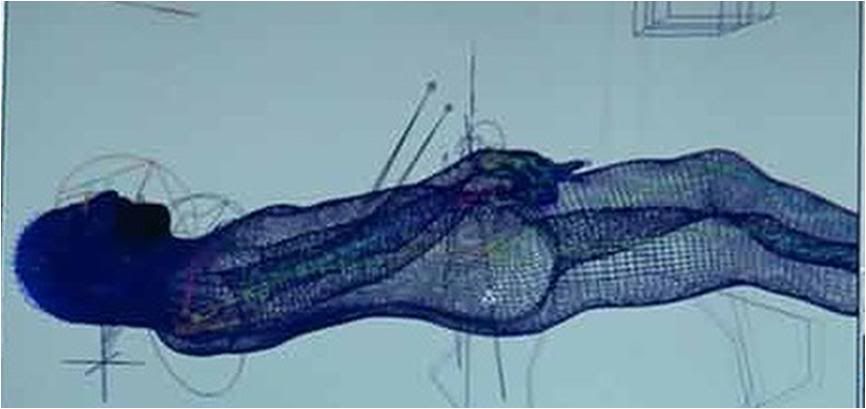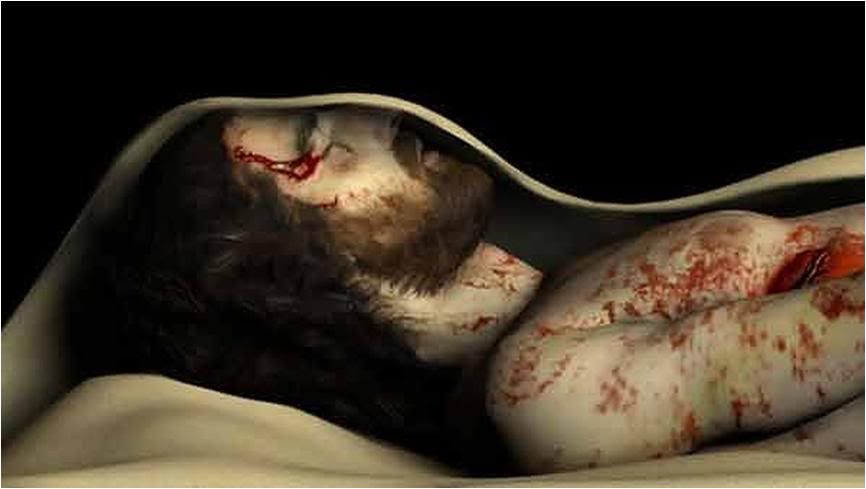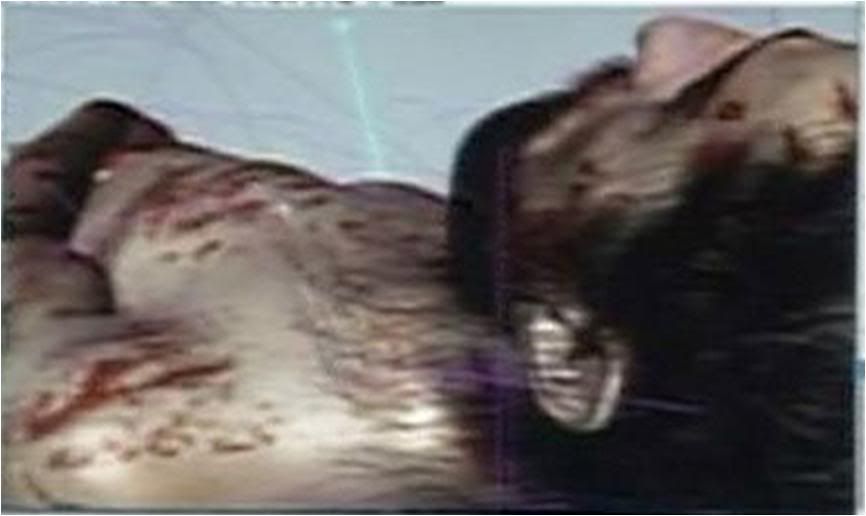 Public to get latest peek
Public to get latest peek
at the Shroud of
By FRANCESCO MANETTI and FRANCES D'EMILIO

TURIN, April 9 (AP) - The long linen with the faded image of a bearded man is the object of centuries-old fascination and wonderment, and closely kept under wrap.
Starting Saturday, and for six weeks, both the curious and those convinced the Turin Shroud is the burial cloth of Jesus Christ can have a brief look.
By late Friday, 1.5 million people had reserved their three-to-five-minute chance to gaze at the cloth, which is kept in a bulletproof, climate-controlled case.
Organizers said earlier this year they hoped some 2 million pilgrims and tourists would see the linen during the special viewing from April 10 to May 23.
That number doesn't include Pope Benedict XVI, who will fly up to Turin, Piedmont's capital, in northwest Italy, on May 2 for a day trip to pray before the Shroud.
Traditionally, the public gets a peek at the 14-foot-long, 3.5-foot-wide (4.3-meter-long, 1 meter-wide) cloth only once every 25 years. But recent decades have seen much shorter intervals. The Shroud went on display in 1998 after a 20-year-wait and then in 2000 during theMillennium celebrations.
Church officials resisted putting the cloth on display when tourists poured into Turin in 2006 for the Winter Olympics. But, as city officials recently put it, in a nod to the "importance to the economy and employment" of this city that is automaker Fiat's hometown, they allowed that is being billed as the "first showing of the new millennium."
Since the linen's previous showing a decade earlier, restorers have removed patches sewn on by nuns in 1534, two years after a fire damaged the case then holding the it, Shroud Museum director Gian Maria Zaccone said in an interview with Associated Press Television News.
Taking off the patches allowed the linen to be fully extended and let restorers smooth out creases in what for centuries had been a rolled-up cloth, making for what restorers hope will be better preservation.
"A challenge to the intelligence" is how John Paul II defined the cloth in 1998 when he journeyed to Turin to view it. In a major papal pronouncement about the Shroud, the late pope asked experts to study it without preconceptions using "scientific methodology" while keeping in mind the "sensibility of the faithful."
His balanced instruction reflected a Vatican tiptoe around the issue of just what the cloth is, calling it a powerful symbol of Christ's suffering while making no claim on its authenticity.
A Vatican researcher said late last year that faint writing on the linen, which she studied through computer-enhanced images, proves the cloth was used to wrap Jesus' body after his crucifixion.
But experts stand by carbon-dating of scraps of the cloth that determine the linen was made in the 13th or 14th century in a kind of medieval forgery. That testing didn't explain how the image of the shroud - of a man with wounds similar to those suffered by Christ - was formed.
However, some have suggested the dating results might have been skewed by contamination and called for a larger sample to be analyzed.
Among those in Turin on Friday for the start of the viewings this weekend was Antonio Lambatti, a professor of Christian history at the University of Parma, who describes himself as a skeptic.
"In my judgment, it's a fake," Lambatti told APTN. He cited historical research, specifically a declaration by a Church official in 1355 that the cloth was a "representation" of the original cloth.
But the fascination about the shroud "goes beyond history and archaeology," Lambatti acknowledged. "It implies a choice of faith."
Besides the 16th-century blaze, the cloth has had other brushes with disasters, including a 1997 fire in the cathedral.
It also might have survived the covetous clutches of Hitler.
In the early weeks of World War II, the cloth was secretly whisked from its resting place in the cathedral to a monastery in Montevergine in the southern Apennine mountains, recalled Rev. Andrea Davide Cardin, director of Montevergine's state library.
"It wasn't so much that Hitler was looking for it, but that the Nazi hierarchy wanted it as a symbol of power, of omnipotence," Cardin said in a telephone interview with The Associated Press in Rome.
Because of a friendship between the monastery's chief abbot and the Savoys, the Piedmont royal family, long custodian of the Shroud, Montevergine was chosen for safekeeping, and a hiding place carved in a wooden altar in a chapel of the abbey, Cardin said.
"During the war, no one knew it was there, except for the Victor Emmanuel III (then king of Italy), the head abbot and the Vatican secretary of state," he said.
The shroud was returned to Turin's cathedral in 1946, after the war's end, Cardin said. "What would have happened if, instead of entrusting it to the Benedictine monks of Montevergine, it was entrusted to the monks of Monte Cassino?" Cardin said, saying he was quoting a 1946 letter from then Turin Cardinal Maurilio Fossati in tribute to the shroud's survival.
The Benedictine monastery at Monte Cassino, about 90 miles (150 kilometers) to the northwest, was heavily bombed by the Allies in 1944, and many Savoy family documents about the shroud that were placed there for safekeeping during the war were destroyed, Cardin said.
Of course, just before Holy Week, some buzz was generated by a digital reconstruction of the face of Jesus from the features imrpinted on the Shroud of Turin. Somehow, I think, the facat that the media practically ignored what is at least 'interesting' news is an indication of how little MSM thinks of Jesus Christ. As presumably, most of the MSM liberals do not believe in God anyway, to them Jesus was just another 'itinerant Jewish preacher' who travelled the roads of Galilee under the reign of Augustus Caesar
Is this the real face of Jesus?
by ANITA SINGH

Using the latest 3-D computer technology, a team of digital artists have created what they claim is the real face of Jesus.


The contours of the face and body were taken from the ghostly face imprinted on the Shroud, the bloodied linen sheet said to have covered the body of Christ in his tomb.
Months of painstaking work went into the reconstruction, which is the first of its kind. The results were recorded by The History Channel for a two-part documentary,
The Real Face Of Jesus, broadcast this week.
"If you want to recreate the face of Jesus and you want to get the actual face of Jesus, you only have one object and that's the shroud," said Ray Downing, lead artist on the project.
"I have a lot of information about that face and my estimation is we're pretty darn close to what this man looked like."

The face they have created looks very different from the image on the Shroud, Mr Downing explained, because it has been transformed from 2-D to 3-D.
"The shroud wasn't hanging on the wall - it was wrapping a corpse. The face is hidden in there. By imitating those distortions we could take the image and put it back into shape and figure out what the face looked like. It gave us a blueprint," he said.
Debate has raged for centuries about the authenticity of the Shroud. In 1988, carbon dating tests appeared to show that the material dated back to between 1260 and 1390, suggesting that it was a medieval forgery.
I did not see the documentary, and I hope I can catch it some time soon on TV, but the reconstructions shown correspond to my idea of the figure that the Shroud enclosed. I'm a 'true believer' about many things about the faith which may be considered peripheral because they do noy really affect one's belief in the essentials of the faith.
So it is with the relics of saints, and the two 'relics' that I consider inherently authentic - the Shroud of Turin and the Face in Manoppello. But belief in these 'peripherals' does tend to reinforce belief in the essentials...
[Modificato da TERESA BENEDETTA 10/04/2010 04:32]